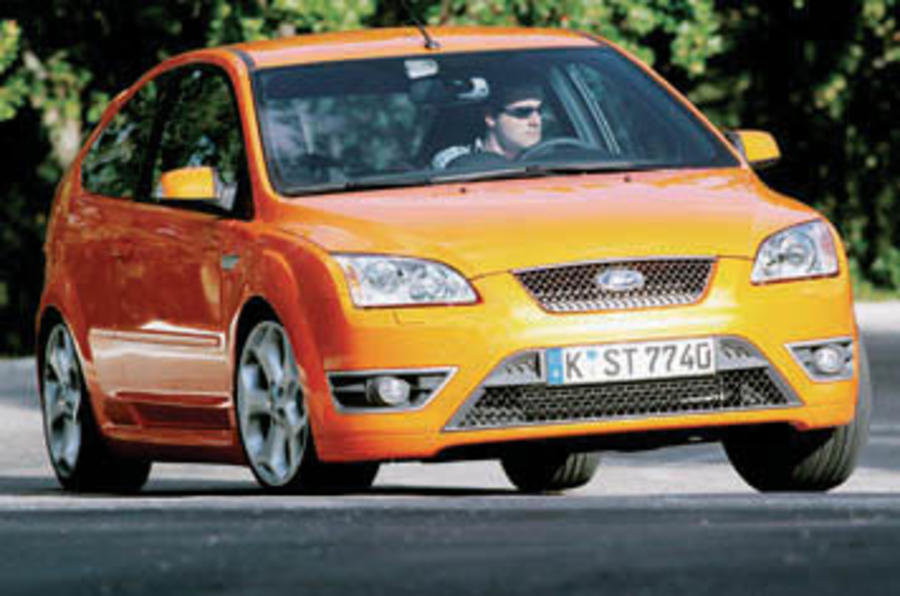THERE’S A THIN LAYER of mist this morning as I pad quietly across the dew to the hotel car park. It’s early and I didn’t sleep much last night. I’d been perplexed: the one car I’d been looking forward to driving perhaps more than any other this year had left me feeling mildly ambivalent; and what’s worse, I couldn’t figure out exactly why.So I had a word with the Ford team, who conjured the same retina-scorching orange Focus ST as yesterday, fully fuelled, warmed, and ready to go while everyone else slept. And so it’s just me and the car. Windows down, air-con off, maximum attack – all thoughts of slumber and breakfast banished.That’s when the road appears. Here, on the doorstep of the Paul Ricard circuit on the southern French coastline, it’s an absolute belter: a ribbon of asphalt that is so challenging and so empty, it’s hard not to burst out loud with laughter. The first downhill hairpin is approaching. Can the ST deliver?Let me rewind the tape slightly. This is a vintage hot-hatch year: we’ve had Mr Angry in the shape of the wildly boosted Astra VXR, and Mr Slick in the attractive clothing of the Golf GTi. But as we all know, a hot-hatch scrap really needs a fast Ford.In theory, it’s the Focus that sounds the most able on paper when you consider Ford’s recent reputation for chassis work, the Focus’s agreed status as the best-handling car in its class and the RS team developing the car.But then details began to creep out which raised the odd eyebrow in the Autocar office. The powerplant was not the expected turbocharged four-cylinder whizz-bang device, but the 2522cc five-cylinder 20-valve turbo motor from the Volvo S40 T5.And then just recently came the news about the price: the ST would start at just £17,495. Was this charity on Ford’s part, or a tacit admission that the ST would get its trousers pulled down by rivals such as the Astra VXR and Mégane Trophy?When we arrive, a hangar at Paul Ricard air strip contains the launch batch of Focus STs. It’s an almost impossibly chunky shape, the ST, adding to the already strong cab-forward Focus form with a front airdam along the same lines as the Fiesta ST’s and deep side sills.Atop the rear hatch sits a pronounced spoiler and in the rear bumper a fat chrome tail pipe on either side. Overall it’s wide and purposeful, although hardly a great beauty.Inside, the changes are relatively subtle – apart from the colour-coded seat bolsters if they’ve been fitted – but it’s clear that the money has been spent where it matters. The standard Recaro seats grip in all the right places and, crucially, are mounted low enough.The steering wheel is thicker with a grippy feel and pronounced hand-holds, and the dials have a sporting font and graphic. On the dashboard top sits a pod angled towards the driver with three gauges: oil temperature, turbo boost and oil pressure – clear evidence of Team RS’s attention to detail and a welcome feature when so many performance cars now ignore the act of informing the enthusiast driver.Ford receives the basic engine as a sealed unit, confining tuning to the KKK-Warner turbo, fuel and ignition systems to change its character. There is 222bhp at 6000rpm and 236lb ft of torque from 1600-4000rpm. Make a note of the last figure. It’s going to be quite important later on.Underneath, springs are 30 per cent stiffer front and rear, dampers are retuned, there’s a 15mm ride height drop and a 5 per cent stiffer rear anti-roll bar.It only takes the first mile to feel how easy-going the Focus ST is in character, but even before that, you’ve determined what language it speaks: there’s an assault of gruff five-pot noise that burrows its way through the bulkhead in front of you. Ford says it has engineered a path for the sound waves to take into the cabin, but who cares if there’s some contrivance going on when a car sounds this good?It sounds best at low revs and, unsurprisingly considering that torque figure, this is where it feels the strongest. This is an alien concept in a hot hatch: there’s so much pulling power down here that at one point it pulled from 600rpm in fifth without protest.The peak torque range is a predictably heady source of acceleration, and then above 4000rpm the note turns into a wild bray and the power continues to build.It’s from 5000-6000rpm that the force seems to die away. The initial conclusion is that the more you thrash the ST, the more frantic braying you get for little extra reward. Bottom line, it doesn’t feel that fast when caned through the gears, and the doubts over the choice of engine are gathering again.As mentioned, the ST is an amiable device. There’s the flexibility of the engine of course, and the surprisingly supple ride – far more so than the incessant jolting you get when behind the wheel of an Astra VXR. The gearshift is precise, but occasionally requires a firm hand to scythe through a slightly stodgy section of the throw, while the brakes are light to the toes in the first inch of travel.As the road tightens and starts to twist and turn endlessly, the steering proves accurate and precise but rather light with a dash of steering feedback. All very pleasant, and a boon for everyday practicality, but not quite the gritty driving machine you’d have expected.With eight-inch-wide Continentals it’s clear the ST generates more than healthy grip levels, but with each hairpin there’s a sensation that the nose doesn’t want to turn in quite as keenly as you’d hope and you wonder about the extra weight of the five-cylinder engine.It’s not chronic understeer, just that those expecting the hyperactive turn-in and pivoting around the centre of the VXR will find a much calmer experience; one where a lift of the throttle has less of an effect on the cornering stance of the car.As we drive back for the night I click the electric steering pump onto sport mode – as opposed to the standard setting we were recommended for road use – and there’s appreciably more weight to the helm. That’s a positive, and the ST has impressed on this first day, but more as an honest all-rounder, without really getting under my skin.Back to the present and I know it was a good idea to get up early this morning. My right foot rolls off the brake and blips the accelerator as the hairpin approaches. This time I turn in more smoothly and don’t expect too much in the first split second of the turn. Once the tyres have bitten, the nose locks on really well and you can be surprisingly liberal with the power.This is an option thanks to the ST’s linear power delivery: if this was a VXR, we’d be disappearing in a cloud of uncontrollable wheelspin about now.Growl down the next short straight using the torque in second gear and it’s clear that the best idea is to change up as soon as you can – you can use the revs more in the higher gears where the engine runs different calibration. The best thing is to forget about the rev counter and drive the engine on what you feel.The din is echoing off the hillside as I lift for the next corner. Not a distant pop, but a full-on rally-style bang with each throttle lift. Through the next series of sweepers and the car comes alive: the weightier sport steering promotes more confidence and a dose of left-foot braking has the nose right into the apex and the tail swinging. Suddenly the ST is an engrossing experience.The road is over far too soon but the ST has made its point: you want to revel in its homogeneity, its faithfulness, its big-hearted character. There’s an honest charm to the ST that will make it a rewarding, but very easy car to live with, and it’s also cracking value. Yet it takes learning to fully appreciate it.Adam Towler


































Add your comment